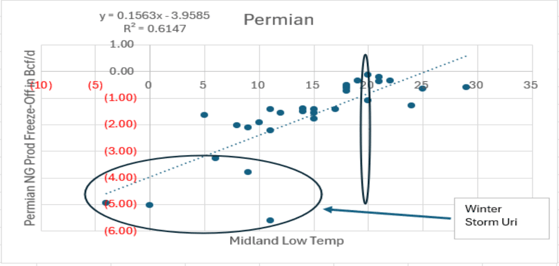2/11/2025
Reviewing Freeze Offs in the Permian and Northeast
SynMax Research:
"Freeze-offs" is not merely a technical detail; it is the linchpin of winter price volatility and supply chain risk. Freeze-offs—the process where freezing temperatures cause water or hydrates in the gas stream to ice up and block wellheads, processing plants, or pipelines—have been the single most critical factor behind major market spikes and supply shortages in recent U.S. history (e.g., Winter Storm Uri 2021, which saw peak production declines of over 14 Bcf/d, and Winter Storm Elliott 2022, which saw peak declines of over 10 Bcf/d).
Permian Basin
The Permian Basin has historically proven to be a highly sensitive basin to natural gas production freeze-offs due to a general lack of weatherization.
- Natural gas production freeze-offs on average begin to occur when temperature lows in Midland, Texas, reach the 20-35 F range. Production loss accelerates significantly as low temperatures fall further below 20F.
- The most critical factor determining the total volume of lost production is whether the freeze event is coupled with widespread power outages in the basin. Additional power loss will cause incremental production losses above and beyond what any historical temperature-only regression would indicate.
- This was starkly evidenced during Winter Storm Uri in February 2021, where the widespread loss of power exacerbated the drop in natural gas supply, preventing operators from running equipment (like heating units and compression) necessary to mitigate freeze-offs.

Northeast
Natural gas production freeze-offs in the Northeast (Appalachian Basin) were also significantly impacted by additional power outages in the region, leading to much larger supply curtailments than historical temperature-only models would have estimated.
- The power outage multiplier effect is quantifiable: The beta relationship between the Pittsburgh low temperature and the amount of Northeast natural gas production freeze-offs went from a baseline of 0.0175 to 0.0613 when Winter Storm Elliott hit in December 2022 with the additional power outages.
- This demonstrates that the temperature sensitivity factor more than triples when a production freeze-off event is coupled with a higher-than-usual amount of power outages.
- Typically, Northeast production freeze-offs begin when the temperature high in Pittsburgh drops to approximately 22F.


Summary: The Two-Factor Model Imperative
While it is fundamental to utilize temperature data—specifically the low temperature thresholds for Midland 20F to 35F and Pittsburgh (22F hight)—to forecast natural gas production freeze-offs, relying solely on weather is a critical failure. It is essential to integrate the amount of power outages in the basin as a co-indicator to accurately estimate the true depth and duration of supply disruption. Hyperion’s long-term production forecast takes into account production freeze-offs with normal weather. Hyperion’s short-term production forecast is a forecast of productive capacity and does not take into account production freeze-offs.